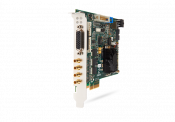Euresys Frame grabber supports laser triangulation

Calculating height profiles from image data places a heavy load on the CPU of a machine vision system. Point clouds must be extracted from the laser line of the image and converted into height profiles. Triangulation then works on the basis of these height profiles. If high resolutions are involved, the extraction of the height profiles from the camera image can cause a CPU load bottleneck in laser triangulation.
Transferring this CPU-intensive task to the highly specialized frame grabber takes off a substantial part from the CPU load.
Coaxlink-Quad-3D-LL generates topographic height profiles
Euresys’ new Coaxlink-Quad-3D-LL is a high-speed frame grabber that generates height profiles from the camera image with the projected laser line within the frame grabber. Euresys provides three different real-time algorithms in the grabber FPGA to calculate the profile from the point cloud: peak, maximum and focus. This results in topographic 16-bit profiles like those created by integrated 3D sensors. These profiles are then transferred to standard machine vision libraries such as Point Cloud Library (PCL). Processing is completed in real time, i.e. as the image is collected. Data rates of up to 625MB/sec per channel are possible. Up to four triangulation units are supported in parallel on a PCI Expres card, each comprising a CoaXPress camera and a lighting unit.
With the hr25MCX, SVS-Vistek offers a high-resolution, perfectly harmonized 4-line CoaXPress-6 camera with a data rate of up to 25 Gbit/s (max. line length 5,120 pixels). The even higher-resolution shr47051MCX with a line length of up to 8,864 pixels is expected to go into series production at the beginning of Q3/2017.
Swift and inexpensive laser triangulation
The use of highly optimized hardware in connection with a powerful CoaXPress interface permits powerful and extremely swift laser triangulation. This lowers software resource requirements for integrators (and thus saves time and money), while offering top performance. This leaves the CPU of the host system with more reserves for performing actual triangulation. This year, Euresys will be widening its 3D portfolio and introducing a 3D vision library.